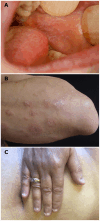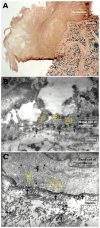Lichen planus pemphigoides with predominant mucous membrane involvement: a series of 12 patients and a literature review
- PMID: 38686381
- PMCID: PMC11057232
- DOI: 10.3389/fimmu.2024.1243566
Lichen planus pemphigoides with predominant mucous membrane involvement: a series of 12 patients and a literature review
Abstract
Background: Lichen planus pemphigoides (LPP), an association between lichen planus and bullous pemphigoid lesions, is a rare subepithelial autoimmune bullous disease. Mucous membrane involvement has been reported previously; however, it has never been specifically studied.
Methods: We report on 12 cases of LPP with predominant or exclusive mucous membrane involvement. The diagnosis of LPP was based on the presence of lichenoid infiltrates in histology and immune deposits in the basement membrane zone in direct immunofluorescence and/or immunoelectron microscopy. Our systematic review of the literature, performed according to the Preferred Reporting Items for Systematic Reviews and Meta-Analyses guidelines, highlights the clinical and immunological characteristics of LPP, with or without mucous membrane involvement.
Results: Corticosteroids are the most frequently used treatment, with better outcomes in LPP with skin involvement alone than in that with mucous membrane involvement. Our results suggest that immunomodulators represent an alternative first-line treatment for patients with predominant mucous membrane involvement.
Keywords: autoimmune blistering dermatosis; autoimmune blistering disease; bullous pemphigoid; lichen planus pemphigoides; mucous membrane pemphigoid; oral lichen planus.
Copyright © 2024 Combemale, Bohelay, Sitbon, Ahouach, Alexandre, Martin, Pascal, Soued, Doan, Morin, Grootenboer-Mignot, Caux, Prost-Squarcioni and Le Roux-Villet.
Conflict of interest statement
The authors declare that the research was conducted in the absence of any commercial or financial relationships that could be construed as a potential conflict of interest.
Figures





References
-
- Kaposi M. Lichen ruber pemphigoides. Arch J Dermatol Syph. (1892) 24:343–6.
-
- Cognat T, Gayrard L, Adam C, Balmex B, MaChado P, Nicolas JF, et al. . Lichen plan pemphigoïde [Lichen planus pemphigoides]. Ann Dermatol Venereol. (1991) 118:387–90. - PubMed
-
- Ogg GS, Bhogal BS, Hashimoto T, Coleman R, Barker JN. Ramipril-associated lichen planus pemphigoides. Br J Dermatol. (1997) 136:412–4. - PubMed
Publication types
MeSH terms
LinkOut - more resources
Full Text Sources

